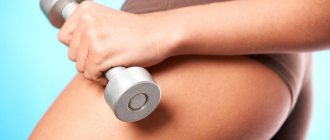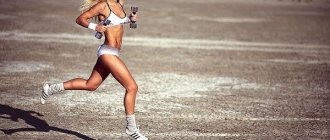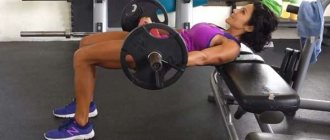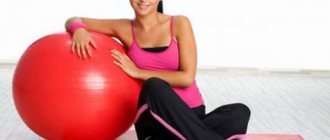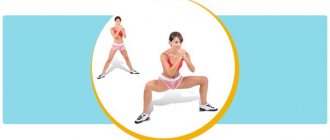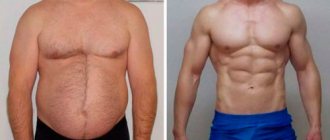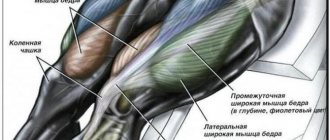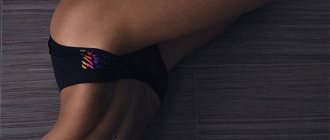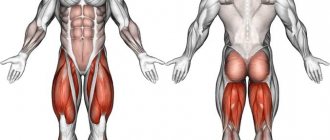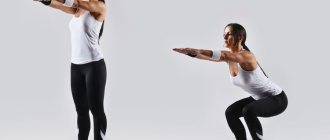Location and anatomy of the gluteus maximus muscle
The gluteus maximus muscle is one of the largest in the body. It not only gives shape to the buttocks, supports the other 2 muscles (minimum and medius) in this area, but also helps move the hip.
The muscular structure is located on the back of the pelvic region behind the surface of the sacrum and the iliac crest.
Origin of muscle
The gluteus maximus muscle, the functions of which have developed in accordance with the phases of evolutionary change in the human body, has a highly feathery, fibrous structure. It is the most superficial of the 3 gluteal muscles.
The muscle is attached to several places:
- posterior surface of the ilium;
- erector spinae muscles;
- from the dorsal surface of the lower part of the sacrum and part of the coccyx;
- sacrotuberous ligament and fascia covering the gluteus medius muscle.
The upper part of the gluteus maximus muscle is attached to the more superficial fibers of the lower part, ending in a thick, flat tendon. It passes lateral to the greater trochanter and connects with the iliotibial ligament of the fascia lata.
The gluteus maximus muscle, forming the external anatomy of the buttocks, makes up the outermost layer of the dorsal gluteal musculature.
Attachment
Approximately 75% of the muscle fibers are inserted into the iliotibial tract of the fascia lata, which runs along the upper part of the pelvis, and 25% of the fibers are inserted into the gluteal tuberosity of the thigh.
Innervation
The muscle structure is innervated by the inferior gluteal nerve, a branch of the sacral plexus (L4-S2). Below the muscle are blood vessels and nerves, including the sciatic, pudendal, and superior gluteal vessels.
What functions does the muscle perform and what is it responsible for?
The gluteus maximus muscle, whose function is to move the hips, is connected to the tailbone and other surrounding bones. This strong muscle acts as a spring for the fascia lata and, connecting with the iliotibial band, fixes the femur to the articular surfaces of the tibia. The lower part of the muscle functions as an adductor and external rotator of the lower limb. The superior fibers promote abduction of the hip joints.
| Action | Sequencing |
| Extension of the body | When tilting, flexion/extension occurs at the hip joint. The muscle exit site will be a moving point, and the insertion site will be a stable point. At the moment the points come together, the body straightens. When in the neutral position, this feature supports the body, preventing it from falling. |
| Hip abduction | It is created by the upper sections of the gluteus maximus muscle, which is facilitated by the direction of the fibers. |
| Hip extension | Shortening of the muscle at the insertion of the femur causes hip extension. The amplitude of flexion can reach 20˚. |
| Pelvic stabilization | With the help of the femoral heads, the pelvis is balanced by the gluteus maximus muscle. |
| External rotation of the hip | By contracting, the large muscle moves the attachment point on the femur, causing the femur to rotate outward. |
The gluteus maximus muscle performs several important functions in the body.
In the process of everyday movements, the muscle is involved in simple actions: walking, running, bending, sitting on a chair and rising from it.
Gluteus maximus inhibition
Patients with hip or lower back pain often experience relaxation of the gluteal muscles. This is called "gluteal retardation" or "gluteal amnesia."
Suppression of functionality occurs for various reasons:
- Inactivity, sedentary lifestyle. A low level of activation of the gluteal muscles in everyday life makes it difficult to function.
- Shortening of the hip flexors. Low activity and a sedentary lifestyle lead to mechanical limitation (inability to achieve full hip extension) and inhibition of the gluteus maximus muscle.
- Excessive anteversion of the pelvis. This dysfunction results in lengthening of the gluteal muscle, which contributes to its inhibition. Changes in body biomechanics affect the occurrence of lumbar lordosis, muscle weakness, and overstrain of the knee joint.
- Decreased vascular function. Prolonged inactivity reduces vascular viability and impairs the function of the gluteal nerves.
Consequences of muscle inhibition:
- Delayed activation of the gluteus maximus muscle in the hip extension mechanism.
- Excessive activation of synergistic muscles (hamstrings and erector spinae), causing the gluteus to fail to fulfill its primary role as a hip extensor. This condition is associated with lower back pain.
- Excessive increase in lumbar lordosis. A lack of hip mobility may be indicated by the lumbar spine losing its static function and causing lower back pain.
- A hamstring injury occurs when a large muscle that is not performing its function puts excessive stress on the tendon.
- Hip and knee dysfunctions such as knee valgus, iliotibial band syndrome or lack of lumbopelvic stabilization.
Activation of the gluteus maximus muscle
The function of the gluteus maximus muscle as a strong hip extensor is primarily activated during powerful or rapid power movements. These include sprinting, climbing stairs, or from a flexed hip position. But the muscle remains inactive while walking and almost completely inactive while standing. Although it is the largest muscle in the body, it tends to be relatively weak or suppressed in most people, including runners.
Lack of strength or decreased mobility in hip extension affects the ability to swing the leg back during running or straightening up after squats or deadlifts. If the gluteus maximus is not used correctly, the smaller, weaker muscles will try to pick up the slack, but they are not strong enough to do so.
Proper glute activation is important because it helps stabilize the pelvis, and the biomechanics of the hip and leg depend on this stability. In runners, a weak gluteus muscle alters the running gait and can cause imbalances and asymmetries in movement in the hips and lower extremities, which can ultimately lead to pain. There are many exercises to activate the gluteus maximus muscle.
Sex differences in muscle structure and function
Although muscles are considered as a single whole, each muscle nevertheless consists of many muscle fibers, whose contractions together create movements. These muscle fibers are cells that contract and relax in response to messages from the central nervous system.
Each skeletal muscle (quadriceps, calves, gluteals) contains 3 types of muscle fibers:
- slow;
- moderately fast;
- fast.
In general, men's skeletal muscles are larger, and some have a proportionately larger area of fast-twitch muscle fibers (type II) than women. Men's muscle gains are usually stronger and more powerful than women's. Women have 27-35% more slow-twitch type I muscle fibers than men, which are rich in blood-carrying myoglobin. Likewise, female muscles have a greater density of capillaries.
The combination of fibers and a large number of capillaries increases the ability to deliver more blood to the muscles, which accelerates the oxidation of fatty acids. The presence of estrogen in women causes them to accumulate more subcutaneous fat in the buttocks than in men. This explains why women's buttocks are usually rounder and softer than men's.
Thus, the scientists concluded that men's greater strength is due to the presence of larger fibers, and that the difference in strength may be due to a lower proportion of lean tissue.
The interaction of muscle and fat during exercise greatly influences both strength and performance, and this process occurs differently in men and women. Because slow-twitch fibers, which are more abundant in women, can provide their own energy source, sustaining force for long periods of time, they are unable to generate significant muscle force.
Drawing up a workout for pumping the buttocks[edit | edit code]
Before starting a set of exercises for the buttocks, you need to warm up your legs. First, you need to stretch your joints with rotating movements. Then warm up your cardiovascular system with a short jog.
- Number of strength exercises for the buttocks during training
: 3-6 (2-4 basic and 1-3 isolating) - Total number of approaches per workout:
8-15 - Number of repetitions in each approach:
10-15 - Butt training frequency:
1-2 times a week
Start training with light weights and gradually increase the weight. To pump up your buttocks, you need to constantly increase the weight of the weights, lowering them by 1 repetition at each workout. So if you start training with 20 repetitions to failure, then after 3-4 months you should reach 8-10 repetitions to failure. This principle is called linear periodization. This way you increase the intensity linearly.
If your primary goal in training is to pump up your buttocks, then you should set aside a separate day of the week to work them out. In this workout, many include up to 6 exercises for the buttocks, and 2-3 additional ones (for other muscles of the legs and back). However, a large amount of exercise is not necessary. Most experts are inclined to believe that 2 basic exercises (8-10 approaches) and 1 isolating exercise (7-5 approaches) are enough. Basic exercises will involve not only the gluteal muscles, but also the muscles of the hips and lower back.
Split training (two days):
- Day 1: Leg day (focus on the buttocks)
- Day 2: Upper Body Day
Weights[edit | edit code]
Since any repetition scheme gives results at first, in order to build muscle mass it is better not to exceed the 20 repetition limit. By using calf weights, you can work your gluteal muscles more effectively. Unfortunately, shin weights are usually light in weight - from 5 to 10 kilograms. They will be useful for a while, but the weight is not enough to provide stress to your glutes as you build up your strength.
Block simulator[edit | edit code]
In addition to shin weights, you can use cuffs to which the cables of the exercise machine are attached. This will allow you to gradually increase the load. The problem of selecting a load is easily solved thanks to simulators for the gluteal muscles.
Pumping up the buttocks to improve squat results[edit | edit code]
Many people advise to first pump up the buttocks and hamstrings, and only then take on the quadriceps. The reverse order is counterproductive. The same buttocks are the main auxiliary muscles when performing squats. The weakness of an important link will not allow you to develop in squats the level of intensity beyond which the growth of strength and mass of the quadriceps begins.
To pump up your buttocks, you need to do this together with your hamstrings, but if these muscles are especially hard hit by physical inactivity, train them in a separate training program twice a week.
The main exercise here is the Romanian dumbbell deadlift. Dumbbells help you better feel the work of your buttocks. This is explained by the fundamental difference in the biomechanics of deadlifting with different implements. The barbell puts more stress on the back extensors, but you hold the dumbbells much closer to the vertical axis of the body, and therefore the maximum load goes to the muscles of the back of the thighs and buttocks.
Use the pyramid method. Gradually increase the weight of the dumbbells from set to set so that the final deadlift set is extremely heavy. Also, after 5-7 months, you can use periodization of loads.
The single leg press has an important difference from its classic version. It causes a more powerful contraction of the gluteal muscle.
The remaining exercises for the buttocks are auxiliary and represent isolating classics. The main thing in such movements is the laser precision of the technique, and not the magnitude of the workload.
Pumping the gluteal muscles
Butt training for beginners
9 best exercises for pumping up the buttocks at home
Women's muscles differ from men's only in weaker pectoral muscles. Women's leg muscles are completely identical. For this reason, women can also benefit from the program. Only working weights will require adjustments.
Why does the gluteus maximus lose endurance and strength?
As a person ages and becomes less active, muscle fibers also become smaller and weaker. Significant weakening of the tissue in this area leads to poor posture and backward tilt of the pelvis. This is often accompanied by lower back pain and difficulty standing up.
Muscle wasting is a condition that occurs when a person's muscles become wasted, usually due to lack of physical activity. There are a number of circumstances in which muscle wasting is common, such as after an injury or during a period of serious illness when a person is immobilized for a long time.
Why does the gluteus maximus muscle hurt?
Pain in the gluteus maximus muscle occurs for various reasons. These could be injuries during physical activity due to overuse or insufficient stretching, or the consequences of a sedentary lifestyle. Sometimes the pain is caused by sciatica starting in the lower back, which then spreads down the buttocks to the legs.
Many physical activities and sports, such as running or swimming, place intense stress on the gluteus maximus muscle, so injuries associated with these activities are a common source of pain. Anyone who plays sports that involve the gluteus maximus should stretch it and other nearby muscles, such as the hamstrings, before starting.
Sometimes the pain does not arise from problems with the muscle itself, but from pain in the sciatic nerve. This nerve, which runs from the lower back through the buttocks and down to the legs, can be compressed by a herniated disc. The pain in this case can be mild or severe, radiating to one or both buttocks.
Other causes of pain:
- Injuries to the lower extremities, knee or ankle.
- Spinal diseases.
- Reduced pelvic stabilization.
- Trouble with running, walking, or activities that require stability, flexibility, and strength in the legs and hips.
- Decreased range of physical motion during normal activities.
A set of exercises for the buttocks[edit | edit code]
- Romanian deadlift 5x10,8,6,6,6 ( alternative:
lunges) - Single leg press 3x10
- Hyperextensions 3x10
- Pelvic lift 3x15,12,10
- Leg abduction 3x15,12,10
Romanian deadlift with dumbbells[edit | edit code]
Romanian deadlift with dumbbells
START:
Stand up straight, holding dumbbells straight in front of you.
PERFORMANCE:
Keeping your back straight, slowly tilt your body until it is parallel to the floor. From the bottom position, straighten your body with a powerful isolated force from your hamstrings and glutes. While standing, tighten your buttocks statically. The main condition for high impact of the exercise is a straight back. If you, on the contrary, round your back, the load will shift to the spinal extensor muscles.
NOTE:
To enhance the effect of deadlifts on the buttocks, it is recommended to straighten your knees “locked” and keep your legs straight throughout the entire set. However, this technique forces a sharp reduction in the amount of working weight. Maintain a slight bend in your knees and focus on putting as much stress on your glutes as possible.
Single leg press[edit | edit code]
Single Leg Press
START:
Get into a lying position on a leg press machine. Place one foot on the surface of the moving platform. Place your other foot on the floor.
PERFORMANCE:
Take the weight of the platform onto your working leg. Bend your knee and lower it down. Using a strong, controlled force, push the platform up. Do all repetitions with one leg, then switch working legs.
NOTE:
Place the foot of your working leg closer to the top edge of the moving platform. This will increase the load on the muscle.
Back hyperextension[edit | edit code]
Back hyperextension
START:
Take the position of resting your hips on the support pad of the exercise machine. Cross your arms over your chest. Slowly bend at the waist and lower your head towards the floor.
PERFORMANCE:
Keeping your back straight, use a slow and controlled force from your buttocks and hamstrings to straighten your body “in line” with your legs. Without pausing, lower yourself to the starting position. Keep your knees slightly bent throughout the set.
NOTE:
The lower the hip pad is, the greater the load on your buttocks. Conversely, the high position of the pillow, when its upper edge is at the waistline, transfers a significant part of the load to the lower back muscles. If you want to use the gluteal muscles, then you need to keep your back round in both phases of flexion and extension, this way the gluteal muscles are activated best.
Pelvic lift[edit | edit code]
Pelvic lift
START:
Place two benches parallel at a distance slightly less than your height. Take the position of the support on the bench, as in the photo. Place your hands behind your head. Relax your body muscle tone and lower your pelvis low to the floor.
PERFORMANCE:
With a powerful effort, lift your pelvis as high as possible. At the top point, additionally tighten your buttocks statically for a couple of seconds.
NOTE:
To prevent the bench that serves as a footrest from tipping over, move it against the wall.
Taking the leg back[edit | edit code]
Taking the leg back
START:
Attach a soft handle to the end of the pulley cable. Place the foot of one foot into the handle. Lower yourself into a squat and assume a straight arms position with your head facing the block.
PERFORMANCE:
Slowly straighten the knee of your working leg and move your foot back and up as far as possible. Slowly and in a controlled manner return to the starting position.
NOTE:
Women can perform this exercise with a shock absorber.
Source Muscle and Fitness Magazine No. 7

